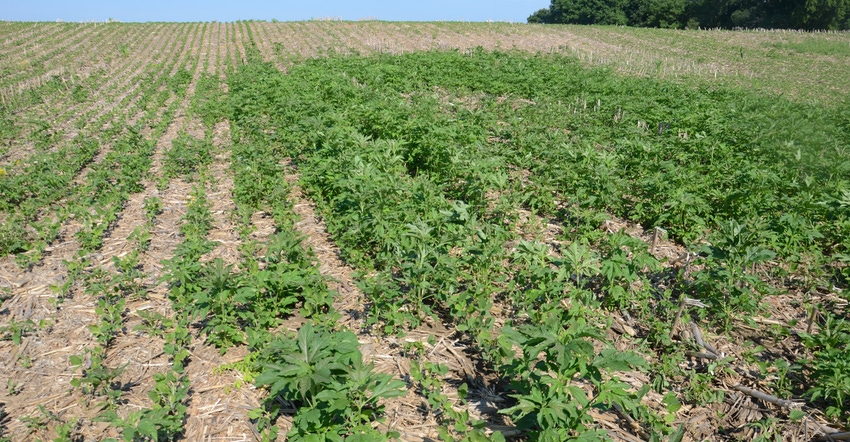
What did the agriculture industry learn about weed control in 2020? How can growers use what was learned to assemble weed control plans for 2021 and beyond?
Willie Vogt, an executive director at Farm Progress, interviewed two Extension weed scientists for the Farm Progress Virtual Experience to address these questions. His guests were Bryan Young, Purdue University weed scientist, and Kevin Bradley, weed control specialist at the University of Missouri.
Here is a snippet of that conversation. Access the entire discussion at FPVExp.com.
Bryan, review 2020 from a weed control standpoint, and tell us what you learned.
Young: It was a challenging year. Some people who went into it with a plan to control tough weeds like waterhemp found that things changed in early June when dicamba products for dicamba-tolerant soybeans were suddenly no longer available. Some resorted to older diphenyl ether chemistry, such as Cobra and Flexstar, and some found out how many PPO-herbicide-resistant waterhemp plants are in their fields.
So, what options do growers have for weed control in 2021?
Young: There are still many postemergence options, some involving herbicide-resistant traits. XtendFlex was just registered for 2021.
I believe, however, that your focus shouldn’t be just on postemergence choices. The use of herbicide-resistant traits and products used with them can be of benefit. However, 80% of your total season-long weed control should come from residual herbicides.
What does all this mean in terms of weed control strategies for 2021?
Young: I believe it should start with soil residual herbicides used at full rates. After recent years, we’re starting to see old problem weeds — such as cocklebur, velvetleaf and giant ragweed — reappear. It’s not all just Palmer amaranth and waterhemp now. If you’ve gone away from glyphosate, you may also be seeing less consistent grass control.
Building a strategy around effective soil residual herbicides applied at full rates and coming back post for escapes or problem weeds, overlapping with another soil residual herbicide, should be an effective strategy. You don’t want to rely on having to control escapes and large weeds post. You may get lucky and pull it off, but luck runs out pretty quick in weed management.
If you are applying post products, how important is weed size?
Young: It’s critical. For 2,4-D and auxin herbicides, it’s better to be spraying 2- to 3-inch-tall weeds than 4- to 6-inch-tall weeds. If the weeds are big enough to see from the road, you should be spraying them. The truth is that if you can see them from the road, it may already be past the best time to spray. You need to walk fields and scout weed size, not just scout from the pickup.
As far as grass control, besides residuals, you may still want to include glyphosate post for consistency in grass control.
Will growers in the future need to take a more holistic approach and consider mechanical control?
Young: Yes, bringing the cultivator back out is one option, but there are other options. John Deere is developing See and Spray, which detects and only sprays weeds. Other companies are working on similar approaches. Others are looking at robots to control weeds, and some are investigating flaming.
Right now, several farmers are using cover crops to help suppress weeds in the spring. That may not be an option for everyone, but those in no-till with cover crops report reasonable success. It depends upon seeding rate for the cover crop, how long you let it grow in the spring and how you terminate it.
Kevin, you’ve also looked at devices that destroy weed seed, correct?
Bradley: Yes, we’re in our second year evaluating a device called the Seed Terminator. It mounts on the back of the combine and is reportedly already on about 100 combines in Australia. There are other companies making similar devices. Thanks to support from the United Soybean Board and our soybean group in Missouri, we’ve been able to evaluate it.
Based on what we’ve seen so far, it does what it says it will do, grinding up even small seeds like waterhemp. The question we’re still looking at is how much seed might not get into the combine. For example, with waterhemp, there can be some scattering of seed at the combine head as the reel operates.
Kevin, you’ve also looked at another option — electrocuting weeds. Tell us about that.
Bradley: Sure. Organic farmers are using electrocution to prevent weeds from producing seed. A company in Sedalia, Mo., Old School Manufacturing LLC, produces the Weed Zapper. Again, thanks to generous support, we purchased one and looked at it in 2020. It appears to do what it says it does. You need a separation in height of the weed above the crop. It electrocutes weeds that it touches, preventing them from producing seed. Right now, the widest bar they offer is 30 foot, so that might be a limitation for a large producer.
Methods like destroying seeds or electrocuting tall weeds are just part of the answer, correct?
Bradley: Yes, in both cases, the goal is simply to reduce the weed seed bank going forward. You still need a long-range plan for controlling weeds all season long.
Young: We need to think about weed control as a long-term process. Growers have sometimes looked for solutions that are easy and cheap. That’s why they turned to herbicides. If growers want to continue to rely just on herbicides going forward, they’re going to have to do a much better job.
A good weed control strategy needs to go further than just one year. We need to consider things such as reducing the seed bank. There is no silver bullet. Controlling weeds in the future will require an integrated approach.
About the Author(s)
You May Also Like




